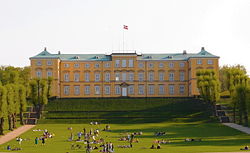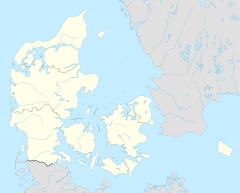
Frederick IV was King of Denmark and Norway from 1699 until his death. Frederick was the son of Christian V of Denmark-Norway and his wife Charlotte Amalie of Hesse-Kassel.

Frederiksborg Castle is a palatial complex in Hillerød, Denmark. It was built as a royal residence for King Christian IV of Denmark-Norway in the early 17th century, replacing an older castle acquired by Frederick II and becoming the largest Renaissance residence in Scandinavia. On three islets in the Slotssøen, it is adjoined by a large formal garden in the Baroque style.

Frederiksberg Gardens is one of the largest and most attractive greenspaces in Copenhagen, Denmark. Together with the adjacent Søndermarken it forms a green area of 64 hectares at the western edge of Inner Copenhagen. It is a romantic landscape garden designed in the English style.

Hirschholm Palace, also known as Hørsholm Palace, was a royal palace located in present-day Hørsholm municipality just north of Copenhagen, Denmark. It was rebuilt in the Baroque style in the 1740s and, one of the finest buildings of its time, it became known as the "Versailles of the North".
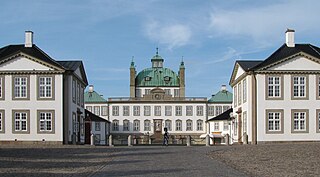
Fredensborg Palace is a palace located on the eastern shore of Lake Esrum in Fredensborg on the island of Zealand (Sjælland) in Denmark. It is the Danish royal family’s spring and autumn residence, and is often the site of important state visits and events in the royal family. It is the most used of the royal family’s residences.
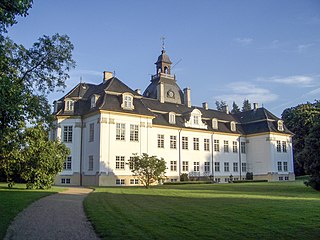
Charlottenlund Palace is a former royal summer residence in Charlottenlund, some 10 km (6 mi) north of central Copenhagen, Denmark. The palace was named after Princess Charlotte Amalie, who was responsible for the construction of the original palace. It was later extended and adapted for Crown Prince Frederick VIII to a design by Ferdinand Meldahl in the early 1880s.

Bernstorff Palace in Gentofte, Copenhagen, Denmark, was built in the middle of the 18th century for Foreign Minister Count Johann Hartwig Ernst von Bernstorff. It remained in the possession of the Bernstorff family until 1812. In 1842, it was bought by Christian VIII. For many years, it was used as a summer residence by Christian IX until his death in 1906.

Charlottenborg Palace is a large town mansion located on the corner of Kongens Nytorv and Nyhavn in Copenhagen, Denmark. Originally built as a residence for Ulrik Frederik Gyldenløve, it has served as the base of the Royal Danish Academy of Fine Arts since its foundation in 1754. Today it also houses Kunsthal Charlottenborg, an institution for contemporary art, and Danmarks Kunstbibliotek, the Royal Art Library.

The architecture of Denmark has its origins in the Viking period, richly revealed by archaeological finds. It became firmly established in the Middle Ages when first Romanesque, then Gothic churches and cathedrals sprang up throughout the country. It was during this period that, in a country with little access to stone, brick became the construction material of choice, not just for churches but also for fortifications and castles.

Sorgenfri Palace is a royal residence of the Danish monarch, located in Lyngby-Taarbæk Municipality, on the east side of Lyngby Kongevej, in the northern suburbs of Copenhagen. The surrounding neighbourhood is called Sorgenfri after it. Only the cellar and foundations survive of the first Sorgenfri House, which was built in 1705 to design by François Dieussart. The current house was built in 1756 by Lauritz de Thurah and later adapted and extended by Peter Meyn in the 1790s. Lauritz de Thurah has also designed buildings which flank the driveway closer to the road.
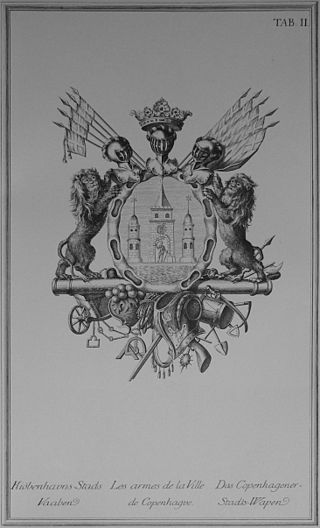
Den Danske Vitruvius is a richly illustrated 18th-century architectural work on Danish monumental buildings of the period, written by the Danish Baroque architect Lauritz de Thurah. It was commissioned by Christian VI in 1735 and published in two volumes between 1746 and 1749. The title refers to the Roman architect and engineer Vitruvius, who published De architectura in the 1st century AD, an authoritative treatise on the architecture of the time. The direct inspiration for de Thurah's Den Danske Vitruvius was Colen Campbell's Vitruvius Britannicus.
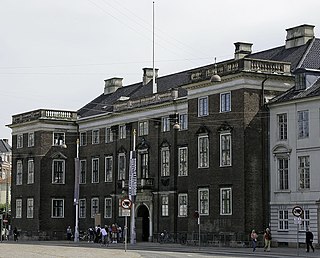
Ewert Janssen or Evert Janssen was a Danish architect who became a royal masterbuilder in 1668. His greatest achievement was Charlottenborg Palace in Copenhagen.

Clausholm Castle is a large Danish country house located some 12 km southeast of Randers in eastern Jutland. It is one of Denmark's finest Baroque buildings.

Johan Conrad Ernst was a Danish architect and royal master builder. He was the son of Johan Adolf Ernst, a successful linen merchant who had immigrated from Nuremberg and had a luxurious residence on Amagertorv in Copenhagen.

Ernst Brandenburger was a Danish master builder and entrepreneur who, through his collaboration with Christof Marselis and Wilhelm Friedrich von Platen (1667-1732), left his mark on Danish Baroque architecture during the early reign of King Frederick IV.
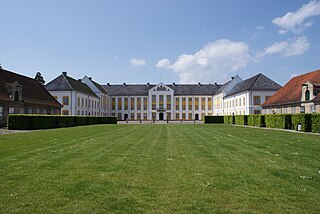
Augustenborg Palace is a Rococo-style palace in the southwestern part of Augustenborg, Als Island, Denmark, overlooking Augustenborg Fjord. The palace owes its name to Duchess Auguste (1633–1701). Augustenborg gave its name to the House of Schleswig-Holstein-Sonderburg-Augustenburg, the last member of which was Duke Christian August II (1798–1869).

Frederiksberg Allé is a tree-lined avenue which runs through the southernmost part of the Frederiksberg district of Copenhagen, Denmark. It connects Vesterbrogade at Værnedamsvej to Frederiksberg Runddel in front of the main entrance to Frederiksberg Gardens. It was originally constructed in 1704 as the king's private road leading to his new summer residence, Frederiksberg Palace. It developed into the backbone of an entertainment district in the mid 18th century, and has continued to be associated with theatres until the present day. The avenue is lined with two double rows of linden trees and bisects Sankt Thomas Plads, a small round plaza, shortly after its departure from Vesterbrogade.

Allégade is the oldest street in the Frederiksberg district of Copenhagen, Denmark. It runs from Frederiksberg Runddel to Frederiksberg Town Hall Square, along the east side of Frederiksberg Gardens, connecting Pile Allé to Falkoner Allé. The streetscape is, in spite of the central location, characterized by houses that are pulled back from the street with front gardens behind white fences. Several buildings are old country houses from the time when Frederiksberg was a summer destination outside Copenhagen. Along the northernmost part of the street, on its west side, is a narrow garden complex, Digterlunden with a statue of Holger Drachmann.

Odense Palace in the city of Odense on the Danish island of Funen has its origins in a 15th-century monastery which passed to the Crown after the Reformation, and since then has served as an administrative building: in turn as a seigneurial residence, an amt administrator's residence, a governor's residence, and a municipal government building. The main white Baroque building with 13 bays was designed by J.C. Krieger and completed in 1723.

Lakajgården is a complex of early 18th-century buildings located on Roskildevej in the Frederiksberg district of Copenhagen, Denmark. Located adjacent to Frederiksberg Palace, a former royal summer residence, it was originally built as stables, kitchen facilities and residential quarters for lackeys. It is a three-winged complex of low yellow buildings with red tile roofs and white windows and cornices. It has been in use by the Royal Danish Military Academy that now occupies Frederiksberg Palace since 1868. The buildings are listed on the Danish Registry of Protected Buildings and Places. A new riding hall was built on the central courtyard of the complex in the late 19th century and has now been converted into an auditorium. It is not listed.
